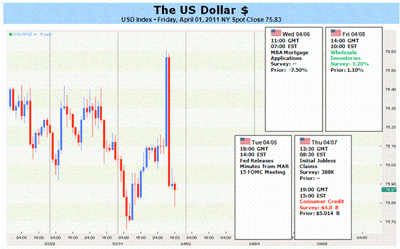The often-pivotal first trading week of April is unfolding with currency traders eagerly awaiting FOMC meeting minutes and other data that weigh heavily on the beaten-down US dollar.
The US dollar finished last week lower against all except the downtrodden Japanese yen, battered by noteworthy gains in the US Dow Jones Industrial Average and broader financial market risk.
A benchmark G10 forex carry trade index matched a record 11 consecutive trading days of rallies—enough for a whopping 8.75% return and a near 800% annualized rate of growth.
The greenback nonetheless showed signs of life amidst hawkish rhetoric from US Federal Reserve officials and a strong non-farm payrolls (NFP) report.
Minutes from the most recent Federal Open Market Committee (FOMC) meeting should provide further insight on future Fed policy, and it will be critical to watch whether the greenback shows signs of life to start the first full trading week in April.
US dollar bulls were disappointed to see a lack of follow through on the post-NFP dollar rally, and indeed we may need to see more than strong economic data to lift the downtrodden currency from important lows.
The greenback currently has the third-lowest short-term interest rate of any member of the G10, making it a funding currency in the forex carry trade. It is subsequently unsurprising to note that USD correlations to the S&P 500 and other risk barometers trade near all-time highs.
Thus the US dollar outlook will not only depend on results from several potentially important pieces of economic event risk, but it will be critical to monitor broader financial market reactions to developments.
A steady stream of commentary from US Federal Reserve officials suggests markets have likely discounted the FOMC’s persistent shift in bias, but minutes from the March 15 policy meeting may nonetheless force volatility on further clarification in sentiment.
The post-decision statement showed FOMC officials expressed concern over inflation and highlighted their belief that “the economic recovery is on a firmer footing.” Key questions remain, but 12-month Fed interest rate expectations are now at their most hawkish since June 2010.
Dollar markets will watch whether the meeting focused on the scheduled end of quantitative easing measures in June. Dovish disappointments would quite likely sink the US dollar further against the high-flying euro and carry trade currencies.
Traders will otherwise keep an eye on results from US ISM Services data and a highly-anticipated European Central Bank interest rate decision. The Volatility Index (VIX) now trades near its lowest levels before the onset of the financial crisis in 2007, emphasizing that financial markets have grown increasingly complacent. The safe-haven US currency will almost certainly underperform through periods of strong risk rallies.
Futures positioning shows that non-commercial traders remain the most net-short the USD against the euro since the pair rallied towards 1.60 in 2007, suggesting we may be at or near an important sentiment extreme.
Yet such extremes are only clear in retrospect, and short-term momentum is plainly in favor of US dollar declines. Forex seasonal tendencies show that currencies tend to make their highs and lows for the month in the first and last trading days of the period. Said tendency tells us we should pay particularly close attention to EUR/USD price action in the first full trading week of April.
Meanwhile, the EUR/USD seems to be at an important juncture, and it will be critical to watch whether FOMC and European Central Bank event risk will force further rallies or a turnaround in the often-pivotal first full trading week of the month.
By David Rodriguez of DailyFX.com






















